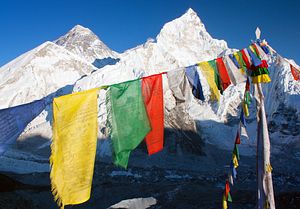When Mount Everest’s spring climbing season opens next month, mountaineers wishing to conquer the world’s highest peak will be greeted by members of the Nepalese army and police force. Following an incident last year, when a group of European climbers and local Sherpa guides engaged in a fistfight at 24,000 feet, government officials deemed it necessary to station authorities at the increasingly crowded thrill-seeking destination.
“We are setting up a government-run tent on base camp so climbers can approach our officers if there are any issues, whether for medical help, rescues or anything else,’’ said Madhusudan Burlakoti, a Ministry of Tourism spokesperson. “We want to make things easier for climbers.”
At present, a “liaison officer” from either the army, police, or tourism department is assigned to each group of climbers when the mountain is busiest – generally from April to May. Once the new base camp tent is established, Burlakoti added, mountaineers will have easier access to officers on the mountain itself rather than having to report incidents at the nearest police station – a seven-day trek away.
As many as nine officers will be on-call at the Everest base camp from March.
Reports about the brawl that initiated the tightening of security at “the roof of the world” are conflicting, with both the European climbers (one each from Italy, Switzerland and the U.K.) and Sherpas pointing the finger at each other. According to climbing magazine Rock and Ice:
The European climbers Simone Moro, Ueli Steck and Jonathan Griffith were attacked by roughly 100 Sherpas at Camp 2 on Everest this past April. The western climbers were on an unsupported ascent of the mountain when their paths crossed with Sherpas fixing lines above Camp 2 for other climbers. After a dispute over icefall that Sherpas said was caused by Moro, Steck and Griffith as they crossed the Sherpas’ ropes, a violent altercation ensued in which the European climbers were physically assaulted and threatened with murder if they didn’t leave the mountain.
The incident is indicative of Everest’s increasing popularity and ease of access. In recent years, some alpinists have reported on-mountain “traffic jams” that can be extremely dangerous at such high altitudes – especially if a climber’s oxygen supply is running low.
Earlier this month, the Nepalese government slashed the “climber’s royalty fee” for those who wish to scale the 29,029-foot mountain.
“As per the revised rate, $11,000 has been fixed for a foreigner aspiring to climb Mount Everest during the spring season from the normal route (South East Ridge). Earlier, the fee was $25,000 per person. Likewise, $10,000 has been fixed for a climber climbing Everest from other routes,” wrote Ekantipur.
The greatly reduced cost is likely to attract even more adrenaline junkies than ever before.
More than 3,000 people have summited Mount Everest since it was first conquered by Edmund Hillary and Tenzing Norgay 1953. Joby Ogwyn, the youngest American to tackle the mountain and current record holder for fastest ascent, announced earlier this week that he would dive from Everest’s peak in a “wingsuit.” The daredevil’s flight will be broadcast live by the Discovery Channel.

































